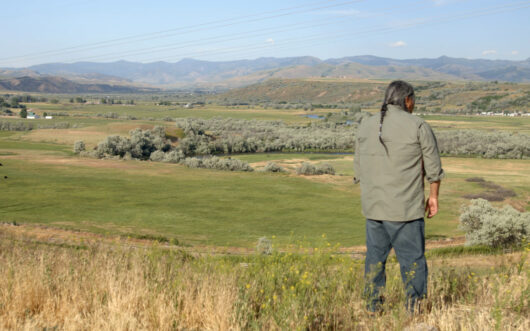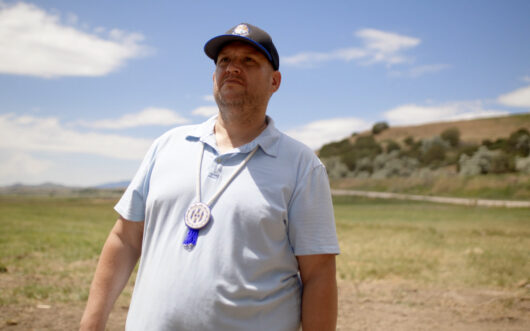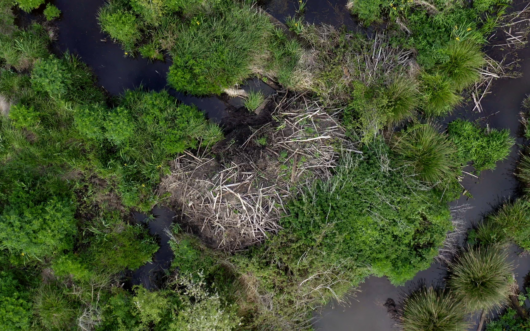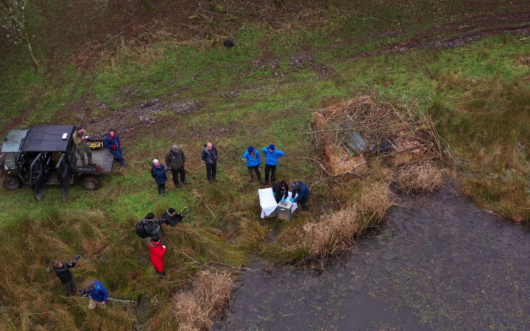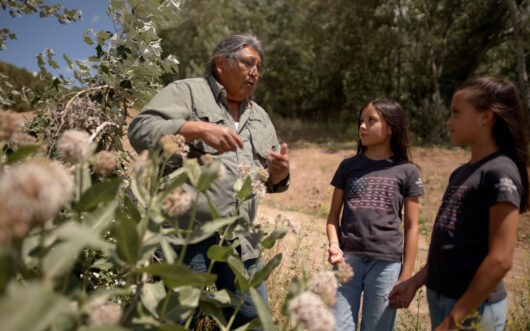In Idaho’s Bear River watershed, the Northwestern Band of the Shoshone Nation have had a busy year planting tens of thousands of native saplings, rerouting water, and tracking the resurgence of life on their land.
For countless generations, the Northwestern Band of the Shoshone Nation gathered at the waters of Wuda Ogwa (Bear River) every winter to fish, connect, and perform their Warm Dance. But on January 29, 1862, this place of celebration turned into a killing ground. The United States Army massacred more than 400 members of the tribe in the largest single loss of Native American lives in U.S. history.
The surviving Northwestern Shoshone were left landless, and the wetlands around Bear River were filled in for intensive agriculture. Settlers planted water-hungry crops and olive trees that replaced the native willows, chokecherries, and cattails. Meandering tributaries were trapped in canals, destroying the area’s natural hydrology.
But more than 150 years later, in 2018, the Northwestern Shoshone were finally able to reclaim the site. They purchased 400 acres in southern Idaho with the goal of restoring lost biodiversity and reviving their connection with the land. Already, the progress has been remarkable.
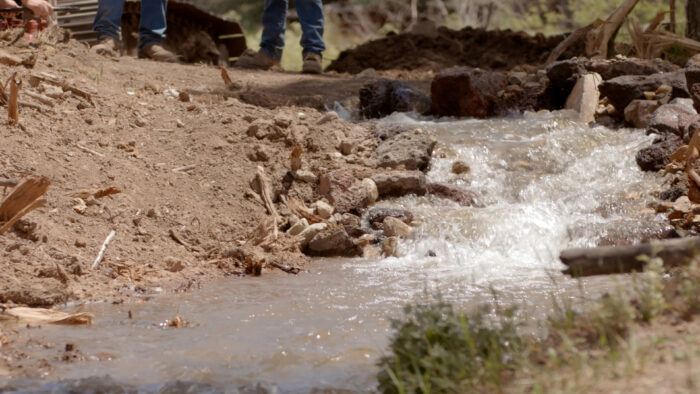
“We’re leading by example and just showing what’s possible,” says Brad Parry, the tribe’s vice chairman.
Much of their progress can be seen in “Wild Hope: Reclaiming Bear River.” The episode shows how the tribe has enlisted the help of scientists, engineers, and the local community to plant native trees, release water from the canal, and build beaver dam analogues to create wetland habitat. But the land has undergone even more dramatic transformations since filming wrapped in August of 2024.
“It looks so different now,” Parry says. “And we’re going to change the landscape even more this year. What you see today is going to look totally different in November.”
Read on to learn about the latest updates from the Wuda Ogwa restoration project.
Invasive trees out, native trees in
When the tribe first began to restore their parcel of land near Preston, Idaho, there was one priority that Parry worried would be impossible — getting rid of the most destructive invasive plant, Russian olive trees.
The Tribal Council wanted them gone — the trees had been planted by settlers as windbreaks and ornamentals and had proved poorly suited to the parched landscape of the Western U.S. A single Russian olive tree can take 75 gallons of water out of the ecosystem every day, and their roots erode the banks of the river, polluting the clear water.
But with hundreds of thousands of the water-guzzling trees on the property, progress felt impossible. “I remember standing and overlooking the site in 2019, going, ‘What are we going to do?’” Parry says. “It just seemed too daunting, and I just thought there’s no way we’re going to get through this.”
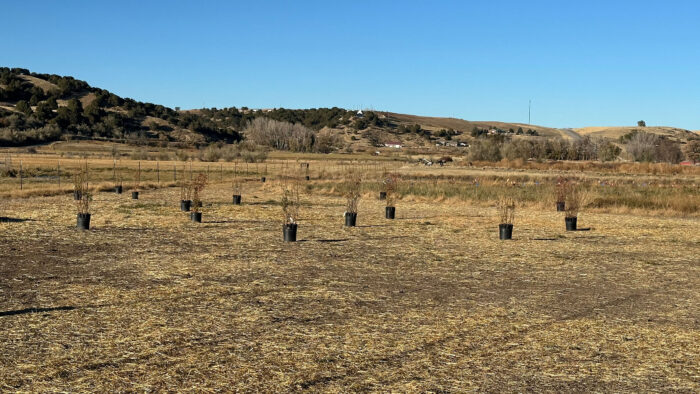
Just over five years later, he’s feeling differently. Last fall, the tribe successfully removed more than 20 acres of Russian olive trees, with another big removal push scheduled for this fall. And native foliage planted in their place will ensure that the Russian olives don’t have an opportunity to make a comeback.
“The new plantings are starting to crowd out the seedlings from Russian olives that would grow,” Parry says. “It’s been a lot of trial and error, but I think our team have really done a phenomenal job.”
Replacing the harmful invasives with habitat-building native plants is key. In “Reclaiming Bear River,” the tribe welcomes hundreds of volunteers to plant 10,000 trees in a day. Last fall, after filming wrapped, more than 400 people came out over a weekend to plant five times that amount: 50,000 native plants and trees. The plan is to plant a similar number this fall, bringing the total up to a staggering 120,000 native plants.
But to ensure those plants can thrive, Parry must focus on rerouting and restoring the lifeblood of any wetland ecosystem — water.
Release the water
Water is central to the success of a wetland. Without it, none of the many plants and animals of the ecosystem can thrive. Parry spends a lot of his time thinking about water — its quality, quantity, and flow through the landscape.
The tribe has been working with biologists and engineers to bring back the natural meandering nature of Battle Creek and restore the area’s hydrology. Ultimately, this will benefit not just the tribe’s land, but the whole Bear River watershed, which feeds the struggling Great Salt Lake.
This fall, the tribe will partner with the U.S. Army Corps of Engineers to reshape the landscape to create a path for Battle Creek to run through. They’ve used lidar to determine the path carved by water in past centuries.
Once the meader is built, engineers will create structures to divert water from the canal to the new path through the landscape. “And Mother Nature takes over from there,” Parry says. “We’re just giving her a little assist because people have pushed her the other way.”
While the full creek redirect won’t be completed until next spring, there will still be plenty to do this summer. Last fall, the tribe dug a wetland pond, planting willows, cattails, and wetland grasses along its edges. The pond is already providing habitat for frogs, snakes, and a pair of nesting sandhill cranes. Wildlife surveys will track the resurgence of life.
“It’s going to be really interesting to see what comes there,” Parry says. “I think we’re going to have to stage a game camera on it.”
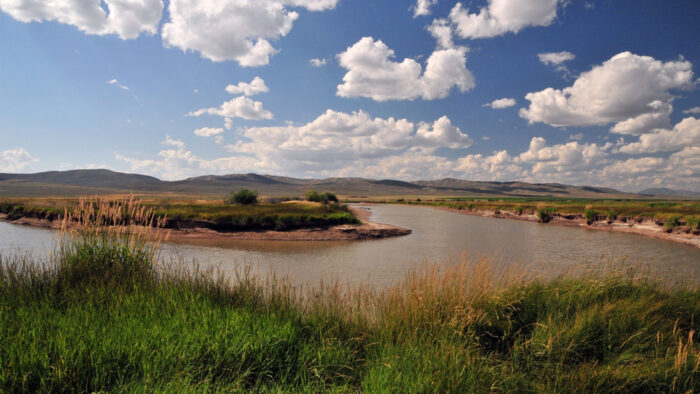
One creature they’re hoping to catch on camera? Beavers. These ecosystem engineers were eradicated from the area when it was converted to farmland. Now, the tribe is hastening their return through human-made beaver dam analogues that kick-start beaver habitat. Already, Parry says, there have been some signs of gnawed willow branches that indicate beavers are moving into the area.
There’s still a ways to go before the wetland looks like it did in the early 1800s, but as the land transforms and the tribe and their partners show what’s possible, more and more people are taking notice and wanting to get involved.
“There aren’t a lot of projects like this, especially in the watershed that we’re in,” Parry says. “That’s what’s really cool about the site. If you get people there, they start thinking about, ‘How can I improve?’ and that’s what we hope to inspire.”

